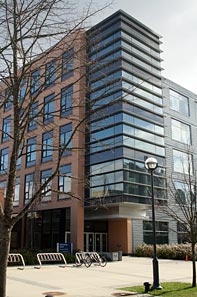Svensson, S.L., Davis, L.M., MacKichan, J.K., Allan, B.J., Pajaniappan, M., Thompson, S.A., and Gaynor, E.C. (2009) “The CprS sensor kinase of the zoonotic pathogen Campylobacter jejuni influences biofilm formation and is required for optimal chick colonization. Mol Microbiol. Jan; 71(1)253-72.
Thompson, S.A., and Gaynor, E.C. (2008). Campylobacter jejuni host tissue tropism: a consequence of its low-carb lifestyle? Cell Host Microbe Nov; 13:4(5)409-10.
Champion, O.L., Valdez, Y., Thorson, L., Guttman, J.A., Menendez, A., Gaynor, E.C., and Finlay, B.B. (2008) “A murine intra peritoneal infection model reveals that host resistance to Campylobacter jejuni is Nramp1 dependent”. Microbes Infect. July; 10(8):922-927.
Svensson, S.L., Frirdich, E., and Gaynor, E.C. (2008) “Survival strategies of Campylobacter jejuni: stress responses, the viable but non-culturable state, and biofilms.” Invited book chapter for Campylobacter, Third Edition, C.M. Szymanski, I. Nachamkin, and M.J. Blaser, eds. (Herndon, VA: ASM Press), pp. 62–85.
Pajaniappan, M., Cawthraw, S.A., Newell, D.G., Gaynor, E.C., Fields, J.A., Rathbun, K., Hall, J.E., Burns, C.M., Kelly, D.J., and Thompson, S.A.. (2008) “A temperature-regulated Campylobacter jejuni gluconate dehydrogenase is involved in respiration-dependent energy production and chicken colonization. Mol. Microbiol, April; 68(2):474-91.
McLennan, M.K., Ringoir, D.D., Frirdich, E., Svensson, S.L., Wells, D.H. Jarrell, H., Szymanski, C.M., and Gaynor, E.C. (2007) “Campylobacter jejuni biofilms up-regulated in a stringent response mutant utilize a calcofluor white-reactive polysaccharide.” J Bacteriol, 90(3):1097-107.
Candon, H.L., Allan, B.J., Fraley, C.D., and Gaynor, E.C. (2007) “Polyphosphate kinase 1 (PPK1) is a pathogenesis determinant in Campylobacter jejuni.” J Bacteriol 189:8099-108.
Lupp, C., Robertson, M.L., Wickham, M.E., Sekirov, I., Champion, O.L., Gaynor, E.C., and Finlay, B.B. (2007). “Host-mediated inflammation disrupts the intestinal microbiota and promotes the overgrowth of Enterobacteriacaea.” Cell Host and Microbe 2:204
Mouery, K., Rader, B.A., Gaynor, E.C., and Guillemin, K. (2006) “The stringent response is required for Helicobacter pylori survival of stationary phase, exposure to acid, and aerobic shock.” J Bacteriol 188:5494-500.
Wells DH, Gaynor EC. Helicobacter pylori initiates the stringent response upon nutrient and pH downshift.
J Bacteriol. 2006 May;188(10):3726-9.
Gaynor EC, Wells DH, MacKichan JK, and Falkow S. The Campylobacter jejuni stringent response controls specific stress survival and virulence-associated phenotypes. Mol Microbiol. 2005 Apr;56(1):8-27.
MacKichan JK, Gaynor EC, Chang C, Cawthraw S, Newell DG, Miller JF, and Falkow S. The Campylobacter jejuni dccRS two-component system is required for optimal in vivo colonization but is dispensable for in vitro growth. Mol Microbiol. 2004 Dec;54(5):1269-86.
Gaynor, E.C., Cawthraw, S., Manning, G., MacKichan, J.K., Falkow, S., and Newell, D.G. (2004) The genome-sequenced variant of Campylobacter jejuni NCTC11168 and the original clonal clinical isolate differ markedly in colonization, gene expression, and virulence-associated phenotypes. J Bact 186:503-17.
Leonard EE 2nd, Takata T, Blaser MJ, Falkow S, Tompkins LS, and Gaynor EC. Use of an open-reading frame-specific Campylobacter jejuni DNA microarray as a new genotyping tool for studying epidemiologically related isolates. J Infect Dis. 2003 Feb 15;187(4):691-4.
Gaynor EC, Ghori N, and Falkow S. Bile-induced ‘pili’ in Campylobacter jejuni are bacteria-independent artifacts of the culture medium. Mol Microbiol. 2001 Mar;39(6):1546-9.
Cornillon S, Pech E, Benghezal M, Ravanel K, Gaynor E, Letourneur F, Bruckert F, and Cosson P. Phg1p is a nine-transmembrane protein superfamily member involved in dictyostelium adhesion and phagocytosis. J Biol Chem. 2000 Nov 3;275(44):34287-92
Gaynor EC, Mondesert G, Grimme SJ, Reed SI, Orlean P, and Emr SD. MCD4 encodes a conserved endoplasmic reticulum membrane protein essential for glycosylphosphatidylinositol anchor synthesis in yeast. Mol Biol Cell. 1999 Mar;10(3):627-48.
Gaynor EC, Graham TR, and Emr SD. COPI in ER/Golgi and intra-Golgi transport: do yeast COPI mutants point the way? Biochim Biophys Acta. 1998 Aug 14;1404(1-2):33-51.
Gaynor EC, Chen CY, Emr SD, and Graham TR. ARF is required for maintenance of yeast Golgi and endosome structure and function. Mol Biol Cell. 1998 Mar;9(3):653-70.
Gaynor EC and Emr SD. COPI-independent anterograde transport: cargo-selective ER to Golgi protein transport in yeast COPI mutants. J Cell Biol. 1997 Feb 24;136(4):789-802.
Letourneur F, Gaynor EC, Hennecke S, Demolliere C, Duden R, Emr SD, Riezman H, and Cosson P. Coatomer is essential for retrieval of dilysine-tagged proteins to the endoplasmic reticulum. Cell. 1994 Dec 30;79(7):1199-207.
Gaynor EC, te Heesen S, Graham TR, Aebi M, and Emr SD. Signal-mediated retrieval of a membrane protein from the Golgi to the ER in yeast. J Cell Biol. 1994 Nov;127(3):653-65.


